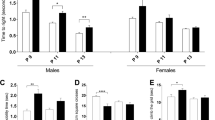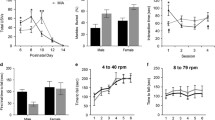Abstract
Autism is a developmental disorder affecting communication, social interaction, motor skills, and cerebellar structure and functions. Recent studies have indicated that maternal infection during brain development may be one of the risk factors for autism. We have previously demonstrated the abnormal overexpression of neurotrophin-3 (NT-3) in autistic cerebellum. To examine further the potential link between autism and maternal infection, and specifically NT-3 expression in the cerebellum, we used maternal lipopolysaccharide (LPS)-exposed rat model of infection. In group 1, pregnant female rats were exposed to 200 μg/kg body weight LPS delivered subcutaneously from gestational days (G) 10 to G15, and pups were exposed to LPS from postnatal days (P) 5 to P10, whereas in group 2, pups were exposed to the same dose of LPS from P5 to P10. There was no change in body mass of pups and mothers following LPS treatment. Cerebellar NT-3 levels were examined by enzyme-linked immunosorbent assay on P6, P12, and P21. We report here that cerebellar NT-3 levels were elevated in pups of both LPS groups as compared to the controls on P21. Our results suggest that altered neurotrophin levels may affect normal brain development and contribute to autistic pathology.

Similar content being viewed by others

References
Baudouin SJ, Gaudias J, Gerharz S, Hatstatt L, Zhou K, Punnakkal P, et al. Shared synaptic pathophysiology in syndromic and nonsyndromic rodent models of autism. Science. 2012;338:128–32.
Kirsten TB, Chaves-Kirsten GP, Chaible LM, Silva AC, Martins DO, Britto LR, et al. Hypoactivity of the central dopaminergic system and autistic-like behavior induced by a single early prenatal exposure to lipopolysaccharide. J Neurosci Res. 2012;90(10):1903–12.
Sulkowski ZL, Chen T, Midha S, Zavacki AM, Sajdel-Sulkowska EM. Maternal thimerosal exposure results in aberrant cerebellar oxidative stress, thyroid hormone metabolism, and motor behavior in rat pups; sex- and strain-dependent effects. Cerebellum. 2012;11:575–86.
Silva MH, Gammon D. An assessment of the developmental, reproductive, and neurotoxicity of endosulfan. Birth Defects Res B Dev Reprod Toxicol. 2009;86:1–28.
Kimura-Kuroda J, Nagata I, Kuroda Y. Disrupting effect of hydroxyl-polychlorinated biphenyl (PCB) congeners on neuronal development of cerebellar Purkinje cells: a possible causal factor for the developmental brain disorders. Chemosphere. 2007;67:S412–20.
Sajdel-Sulkowska EM, Xu M, McGinnis W, Koibuchi N. Brain region-specific changes in oxidative stress and neurotrophin levels in autism spectrum disorders (ASD). Cerebellum. 2011;10:43–8.
Sajdel-Sulkowska EM, Xu M, Koibuchi N. Increase in cerebellar neurotrophin-3 and oxidative stress markers in autism. Cerebellum. 2009;8:366–72.
Das KP, Chao SL, White LD, Haines WT, Harry GJ, Tilson HA, et al. Differential patterns of nerve growth factor, brain-derived neurotrophic factor and neurotrophin-3 mRNA and protein levels in developing regions of rat brain. Neuroscience. 2001;103:739–61.
Li S, Qiu F, Xu A, Price SM, Xiang M. Barhl1 regulates migration and survival of cerebellar granule cells by controlling expression of neurotrophin-3 gene. J Neuroscience. 2004;24:3104–14.
Chao SL, Moss JM, Harry GJ. Lead-induced alterations of apoptosis and neurotrophic factor mRNA in the developing rat cortex, hippocampus, and cerebellum. J Biochem Mol Toxicol. 2007;21:265–72.
Kawakami H, Nitta A, Matsuyama Y, Kamiya M, Satake K, Sato K. Increase in neurotrophin-3 expression followed by Purkinje cell degeneration in the adult rat cerebellum after spinal cord transaction. J Neurosci Res. 2000;62:668–74.
Whitney ER, Kemper TL, Bauman ML, Rosene DL, Blatt GJ. Cerebellar Purkinje cells are reduced in a subpopulation of autistic brains: a stereological experiment using calbindin-D28k. Cerebellum. 2008;7:406–16.
Acknowledgments
This project was supported in part by Grants-in-Aid for Scientific Research from the Ministry of Education, Culture, Sports, Science and Technology of Japan (MEXT) (20510061 and 23510072 to T.I, 21390065 to N.K) and a grant from Ministry of the Environment of Japan (EXTEND 2010 to N.K, T.I, and N.S). Ming Xu is a recipient of Masao Ito Award at 5th International Symposium, the Society for Research on the Cerebellum.
Conflicts of interest
The authors have no current or potential conflicts of interest in this manuscript.
Author information
Authors and Affiliations
Corresponding author
Rights and permissions
About this article
Cite this article
Xu, M., Sajdel-Sulkowska, E.M., Iwasaki, T. et al. Aberrant Cerebellar Neurotrophin-3 Expression Induced by Lipopolysaccharide Exposure During Brain Development. Cerebellum 12, 316–318 (2013). https://doi.org/10.1007/s12311-012-0446-7
Published:
Issue Date:
DOI: https://doi.org/10.1007/s12311-012-0446-7



